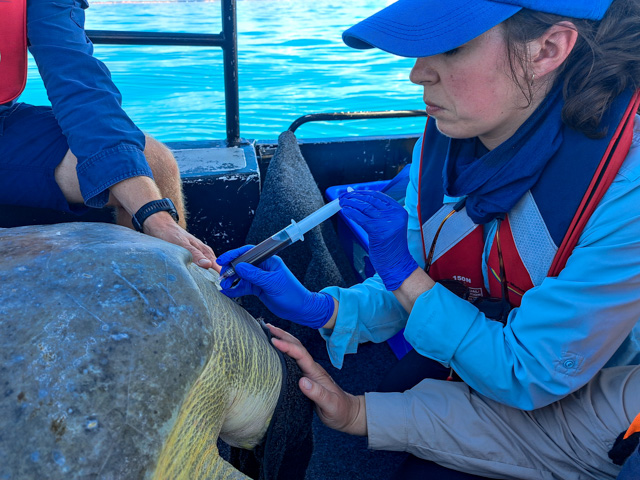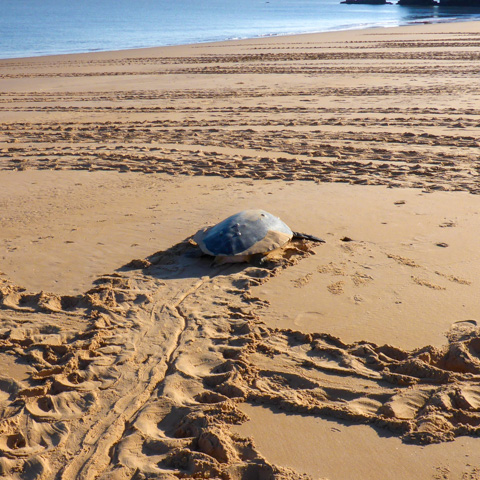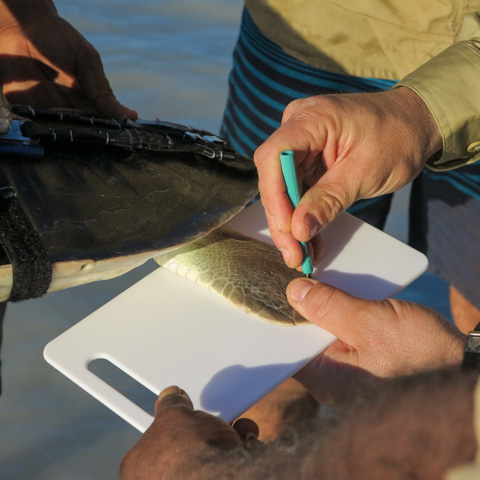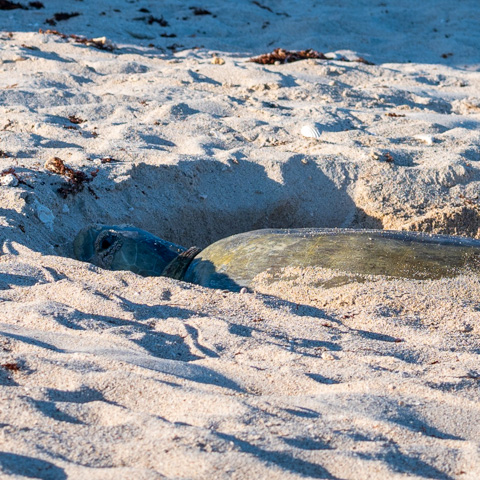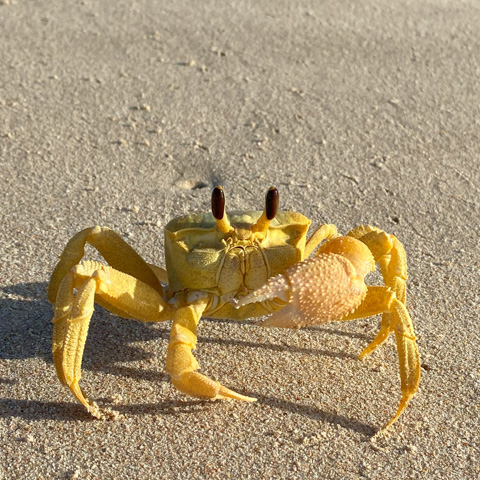Understanding the resilience of the North West Shelf flatback turtle stock
The physical health of flatback turtles can be affected by many factors, including physical harm to their body and impacts from contaminants in their environment. An understanding of these potential impacts and their effects, as well as the anatomy and form of the species, is essential to effectively maintain the health of the North West Shelf flatback turtle stock. This is especially important in areas with significant industrial activity such as WA's North West Shelf.
What we know so far
Minimising potential long-term health impacts from tagging protocols, assessing the concentrations of contaminants in the North West Shelf flatback turtle stock, and the development of blood reference intervals (RIs) to establish baseline health data has been the focus of research on flatback turtle health. The research suggests mercury concentrations in the stock are relatively low in comparison to marine turtles worldwide, and while plutonium levels in new generations of flatback turtles are low they were elevated following nuclear testing in the 1950s.
An accurate 3D model of a flatback turtle has also been created using a contemporary technique called 3D photogrammetry, with a digital version able to be viewed here. This model allows scientists to understand an adult turtle's anatomy and form without harm and assists with educational programs.
PhD student Rosie Brown draws blood from the dorsal cervical sinus of a flatback turtle in Yawuru Nagalugan Roebuck Bay, Western Australia. Photo - Tristan Simpson/DBCA
Research highlights
To address the loss of flipper tags and their potential long-term health impacts, a standardised mark-recapture protocol has been trialled by all flatback turtle monitoring programs in Western Australia. Under this new protocol, all flatback turtles will be tagged with one flipper tag and two Passive Integrated Transponder (PIT) tags in standard locations. This will allow accurate estimation of tag loss, minimise the occurrence of previously tagged individuals going unrecognised, allow for the eventual discontinuation of flipper tags, and increase the amount and quality of data collected at monitored rookeries.
While this new protocol will limit the ability of fishermen and members of the public to easily identify individual flatback turtles, this is a rare occurrence and the lost data risk is low. It will be critical for all research staff to be adequately trained to ensure the correct application and detection of PIT tags, as well as identifying and recording flipper tag scars.
This research was led by DBCA/NWSFTCP, in collaboration with Biomaths Consulting, Care for Hedland, Pendoley Environmental, and Rio Tinto.
Mercury (Hg) pollution in the surface of the ocean has more than doubled over the past century, so how this is affecting the North West Shelf flatback turtle stock is important to know. Researchers investigated mercury concentrations in the skin and carapace of nesting flatback turtles from two rookeries (Thevenard Island and Eighty Mile Beach) and found that concentrations are relatively low in comparison to other marine turtles worldwide, which could be due to the low concentration of mercury in the Australian environment.
The research showed there was not a significant difference in mercury concentration between the two rookeries, despite the hypothesis that the individuals from Thevenard Island would have a higher concentration due to their proximity to industrial activities. It is possible this is due to shared foraging environments, or from mercury emitted by industries being carried inland rather than seaward. It was also found that turtle size did not explain mercury concentrations in the skin, but could explain mercury concentrations in the carapace (shell).
This research was led by the Australian National University, in collaboration with DBCA/NWSFTCP and Murdoch University.
Three nuclear detonations were conducted at the remote Montebello Islands in Western Australia in the 1950s. The remoteness of the islands and lack of disturbance from humans provides a unique opportunity for assessing radionuclides (radioactive atoms) subjected to natural process in a range of ecological habitats, as well as the radionuclide levels in adult sea turtles and their embryos. Sampling of ecological habitats showed that many radionuclides with a short half-life have decreased sharply near the detonation sites, however plutonium (Pu) levels (which have a very long half-life) remain elevated.
During this initial sampling period, plutonium was detected in flatback turtle bone, skin, and eggshell samples. Further research found that the amount of plutonium in developing embryos and hatchlings were much lower than that of the surrounding sands. The majority of the dose to embryos was from the contaminated sands surrounding nests, while majority of the dose to adult turtles was from internalised radionuclides. While the current dose rates of radionuclides are relatively low, they were high for about ten years following the detonations and may have resulted in turtle deaths and/or health impacts to the generation of turtles utilising the most contaminated beaches. Turtles that survived after significant exposures likely carried biomarkers of radiation impacts and some markers may have been passed to offspring.
This research was led by the Australian Nuclear Science and Technology Organisation, in collaboration with DBCA/NWSFTCP and the Australian Radiation Protection and Nuclear Safety Agency.
Blood reference intervals (RIs) are used to compare an individual’s blood test results against what is considered normal for that population, and can be utilised for baseline health surveys, diagnosing disease, monitoring health of individuals and populations, and developing indicators of future health outcomes. As marine turtles are considered an indicator of overall aquatic ecosystem health, changes in RIs over time may indicate an environment in decline.
RIs have been developed for all species of marine turtles except flatback turtles, so researchers worked to fill this gap in knowledge. A healthy reference population was established from nesting and foraging individuals in the North West Shelf, which was then used to develop RIs for two different life stages of flatback turtles (nesting and foraging), as well as separate RIs for laboratory or field techniques.
This research was led by Murdoch University's Conservation Medicine Program, in collaboration with DBCA/NWSFTCP and Murdoch University's Harry Butler Institute.
Publications
2024
2023
2022
- First assessment of mercury (Hg) concentrations in skin and carapace of flatback turtles (Natator depressus) (Garman) from Western Australia
- 3D Visualization processes for recreating and studying organismal form
2020
- Creating 3D models of several sea turtle species as digital voucher specimens
- Radionuclides in sea turtles at the Montebello Islands former nuclear test sites: current and historical dose rates for adults and embryos
2019
Researchers

Dr Scott Whiting
Principal Research Scientist
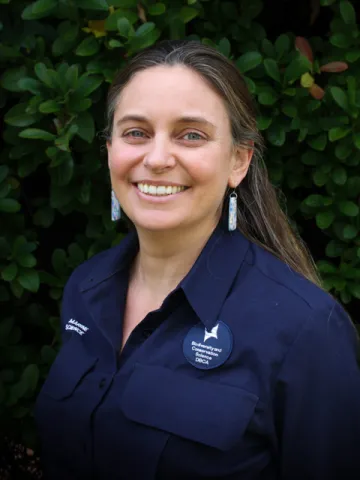
Dr Sabrina Fossette
Senior Research Scientist

Dr Tony Tucker
Senior Research Scientist





